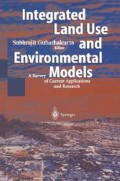Abstract
My fundamental premise is that reaching focused disagreements and then explaining them is fundamental to crafting research agendas and to using urban and environmental models. We should seek neither one integrated research agenda nor one integrated model. We should, instead, create computer modeling environments in which disagreements can emerge and be used to advance knowledge and be used to solve problems. The first use is a way to organize research about land use, environment, and the use of models. The second use is a way to decide what to do in specific situations—to apply the knowledge and models. We should view models and computing tools as additional participants in conversations—interactions about discovering and using knowledge.
Access this chapter
Tax calculation will be finalised at checkout
Purchases are for personal use only
Preview
Unable to display preview. Download preview PDF.
References
Anas, Alex, Richard J. Arnott, and Kenneth A. Small. 1998. Urban spatial structure. Journal of Economic Literature 36 (3): 1426–1464.
Brill, E. Downey Jr., Shoou-Yuh Chang, and Lewis D. Hopkins. 1982. Modeling to generate alternatives: The HS Japproach and an illustration using a problem in land use planning. Management Science 28 (3):221–235.
Brill, E. Downey Jr., John M. Flach, Lewis D. Hopkins, and S. Ranjithan. 1990. MGA: A decision support system for complex, incompletely defined problems. IEEE Transactions on Systems, Man, and Cybernetics 20 (4):745–757.
Foot, David. 1981. Operational urban models. London: Methuen.
Hopkins, Lewis D. 1979. Quadratic versus linear models for land use plan design. Environment and Planning A 11 (3):291–298.
Hopkins, Lewis D. 1977a. Land use plan design: Quadratic assignment and central facility models. Environment and Planning A 9 (6):625–642.
Hopkins, Lewis D. 1977b. Methods for generating land suitability maps: A comparative evaluation. Journal of the American Institute of Planners 43 (4):386–400.
Hopkins, Lewis D., E. Downey Brill Jr., and Benedict Wong. 1982. Generating alternative solutions for dynamic programming models of water resources problems. Water Resources Research 18 (4):782–790.
Hopkins, Lewis D., and Marc Los. 1979. Location-allocation algorithms for land use plan design with fixed and substitutable interactions. Journal of Regional Science 19 (3):345–361.
Lai, Shih-Kung, and Lewis D. Hopkins. 1995. Can decision makers express multiattribute preferences using AHP and MUT? An Experiment. Environment and Planning B: Planning and Design 22 (1):21–34.
Lai, Shih-Kung, and Lewis D. Hopkins. 1989. The meanings of tradeoffs in multi-attribute evaluation methods: A comparison. Environment and Planning B: Planning and Design 16 (2): 155–170.
Lee, Insung, and Lewis D. Hopkins. 1995. Procedural expertise for efficient multiattribute evaluation: A procedural support strategy for CEA. Journal of Planning Education and Research 14 (4):255–268.
Verma, Niraj. 1998. Similarities, connections, and systems: The search for a new rationality for planning and management. Lanham, Md.: Lexington Books.
Waddell, Paul. 2000. A behavioral simulation model for metropolitan policy analysis and planning: Residential location and housing market components of UrbanSim. Environment and Planning B: Planning and Design 27 (2): 247–263.
Wegener, Michael. 1994. Operational urban models: State of the art. Journal of the American Planning Association 60 (1): 17–29.
Westervelt, James. 2001. Simulation modeling for watershed management. New York: Springer-Verlag.
Editor information
Editors and Affiliations
Rights and permissions
Copyright information
© 2003 Springer-Verlag Berlin Heidelberg
About this chapter
Cite this chapter
Hopkins, L.D. (2003). Integrating Knowledge about Land Use and the Environment Through the Use of Multiple Models. In: Guhathakurta, S. (eds) Integrated Land Use and Environmental Models. Springer, Berlin, Heidelberg. https://doi.org/10.1007/978-3-662-05109-2_3
Download citation
DOI: https://doi.org/10.1007/978-3-662-05109-2_3
Publisher Name: Springer, Berlin, Heidelberg
Print ISBN: 978-3-642-05615-4
Online ISBN: 978-3-662-05109-2
eBook Packages: Springer Book Archive

